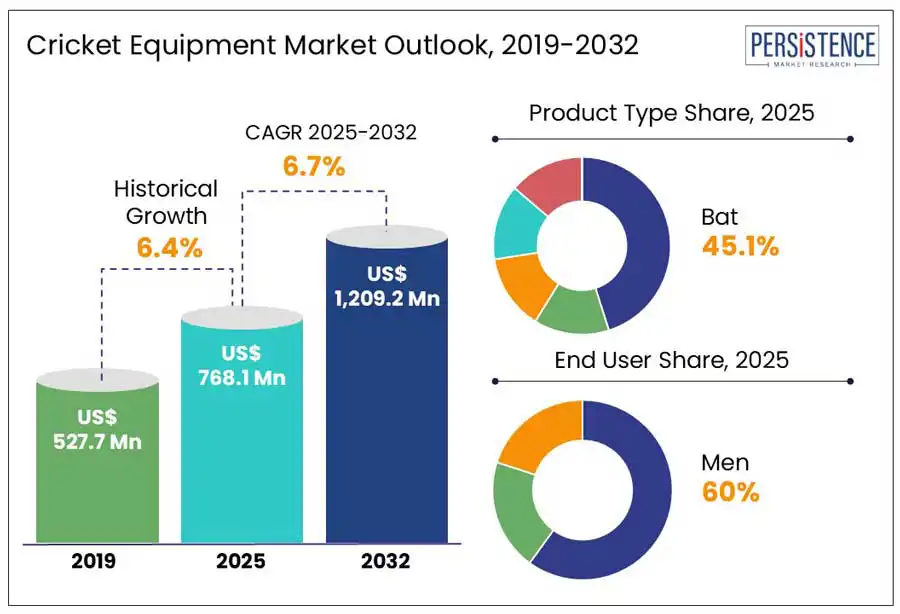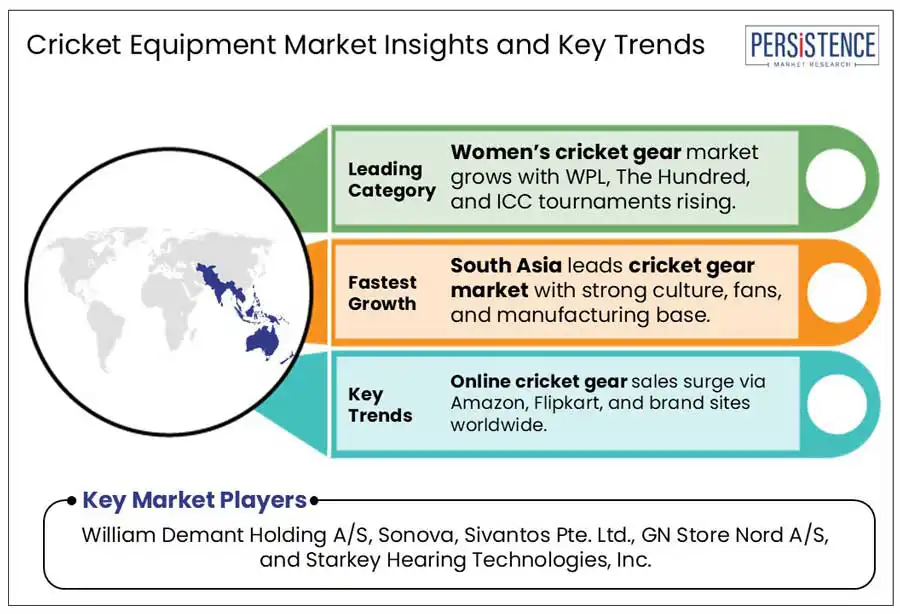Comprehensive Snapshot for Cricket Equipment Market Including Regional and Country Analysis in Brief.
Industry: Consumer Goods
Published Date: April-2025
Format: PPT*, PDF, EXCEL
Delivery Timelines: Contact Sales
Number of Pages: 190
Report ID: PMRREP35205
The global cricket equipment market size is anticipated to rise from US$ 768.1 Mn in 2025 to US$ 1,209.2 Mn by 2032. It is projected to witness a CAGR of 6.7% from 2025 to 2032.
According to Persistence Market Research, the global cricket equipment market is witnessing significant growth, driven by the rising participation of professional players, professional leagues, growing demand for safety gear, and increase in e-commerce sales. According to the International Cricket Council (ICC) cricket has over 2.5 billion fans globally.

Key Industry Highlights:
|
Global Market Attribute |
Key Insights |
|
Cricket Equipment Market Size (2025E) |
US$ 768.1 Mn |
|
Market Value Forecast (2032F) |
US$ 1,209.2 Mn |
|
Projected Growth (CAGR 2025 to 2032) |
6.7% |
|
Historical Market Growth (CAGR 2019 to 2024) |
6.4% |
As cricket is the second most popular sport, it is driven by various formats such as the Indian Premier League (IPL), Big Bash League, and Major League Cricket (MLC) that significantly boosts fan engagement. The IPL has become one of the most lucrative and widely viewed cricket leagues globally. In 2022, the IPL league's brand value was estimated at US$ 11 billion. Moreover, the expansion of women cricket academy, and school-level programs is accelerating the need for bats, balls, protective gear, and other accessories. As cricket has gained traction in emerging markets such as the USA, and Europe, the demand is expected to rise.
The high cost of premium cricket equipment poses a significant restraint on market growth, particularly for amateur players and those in developing regions. Top-quality bats, protective gear, and apparel from brands such as Kookaburra, Gray-Nicolls, and SG is expensive, making them inaccessible to many aspiring cricketers. For instance, professional-grade English willow bats can cost US$ 300– US$1,000, which is unaffordable for many grassroots players. The high cost of premium cricket equipment, with bats like the Gray-Nicolls Legend exceeding US$ 1,350 and SS Ton Gladiator ranging from US$ 810– US$1,215, limits affordability for amateur players. This financial barrier limits participation, especially in regions where the popularity is high but lacks strong funding. As a result, market expansion is restricted due to affordability concerns.
The introduction of cricket programs in schools, universities, and academies presents a significant growth opportunity for the cricket equipment market. Countries such as India, Australia, England, and South Africa have well-established school cricket systems, while emerging markets like the U.S. and UAE are rapidly integrating cricket into academic sports programs. CricKingdom Cricket Academy, spearheaded by Indian Cricketer - Rohit Sharma, introduces a During and After-School Cricket Program that not only nurtures a passion for the game but also enhances essential life skills. This innovative initiative seamlessly aligns with the National Education Policy (NEP) requirements, creating a unique blend of sports and education.
This growing institutional support increases the demand for bats, balls, protective gear, and training equipment. Additionally, the rise of grassroots cricket initiatives and ICC-backed development programs further fuels sales. As more educational institutions adopt cricket, equipment manufacturers and retailers can capitalize on this expanding consumer base.
Bats and balls are the most significant product segments in the cricket equipment market, with bats contributing the largest revenue share. This dominance is driven by high replacement rates, as professional and amateur players frequently upgrade their bats due to wear and performance optimization. Leading brands such as Gray-Nicolls, Kookaburra, and SS Ton offer customized bats tailored to player preferences. With increasing participation in professional leagues, school cricket, and recreational matches, demand for high-quality bats and balls continues to grow worldwide.
?In 2025, Kookaburra introduced the Nickel cricket bat, featuring a full profile with minimal scalloping, a sweet spot approximately 160 to 200 mm from the toe, and edge thickness between 30 mm to 34 mm. Crafted from Grade 2.1 unbleached English willow, it offers a balanced pick-up and enhanced performance for players seeking precision and power.
The women’s cricket equipment market is expanding rapidly, driven by the rise of professional leagues such as the Women’s Premier League (WPL), The Hundred Women, and ICC-backed tournaments. These platforms have significantly increased visibility, sponsorship, and investment in women's cricket, leading to a rising demand for bats, balls, protective gear, and apparel tailored for female players.
As of 2023, the ICC reports that over 1.5 million women and girls are actively participating in cricket worldwide. In Australia, female cricket participation has surged by 67% over the past five years. With more countries developing women’s cricket programs at grassroots and professional levels, the demand for specialized gear is expected to rise exponentially.

South Asia dominates the global cricket equipment market, driven by its deep-rooted cricket culture, a massive and passionate fan base, and a strong manufacturing ecosystem. Countries such as India, Pakistan, and Sri Lanka are home to world-class cricket accessory manufacturers, including SG, SS, Kookaburra, and CA Sports.
Additionally, rising income and increasing participation among the masses has accelerated market growth, making South Asia the fast-growing and most lucrative market for cricket gear.
Africa’s cricket equipment market is growing steadily, driven by increased investment from the ICC, rising grassroots participation, and improved infrastructure. The ICC’s Africa Development Program has introduced funding and coaching initiatives leading to a surge in cricket-playing nations such as South Africa, Kenya, Zimbabwe, and Namibia. Additionally, cricket academies and school programs are expanding, boosting demand for bats, balls, and protective gear.
Infrastructure improvements, including new stadiums and training facilities, have further accelerated this growth. With rising interest in T20 leagues and ICC tournaments, Africa presents a promising market for cricket equipment manufacturers and suppliers.
Australia's cricket equipment market remains strong and evolving, driven by high domestic participation, professional leagues, and technological advancements. The Big Bash League and Women’s Big Bash League continue to boost demand for premium cricket gear. Increasing grassroots participation, supported by Cricket Australia’s development programs, has fueled sales of bats, balls, and protective gear. The 2022-23 season in Australia witnessed a 5% increase in total registered cricket participants, rising from 598,931 to 627,693 individuals engaging in entry-level programs, clubs, and competitions. ?
Additionally, advancements in bat technology, such as lightweight designs and improved materials, are shaping consumer preferences. The growing popularity of women’s cricket and junior programs further encourages the sales. Online retail growth is also making high-end equipment more accessible to Australian players.
The global cricket equipment market is highly competitive, driven by technological advancements, sponsorship deals, and expanding retail networks. Companies focus on innovative materials, lightweight designs, and durability to attract players at all levels. The rise of women’s cricket, T20 leagues, and grassroots programs has intensified competition. E-commerce and customized equipment options are reshaping market trends, increasing accessibility and consumer engagement worldwide.
|
Report Attribute |
Details |
|
Historical Data/Actuals |
2019 - 2024 |
|
Forecast Period |
2025 - 2032 |
|
Market Analysis Units |
Value: US$ Mn/Mn, Volume: As applicable |
|
Geographical Coverage |
|
|
Segmental Coverage |
|
|
Competitive Analysis |
|
|
Report Highlights |
|
|
Customization and Pricing |
Available upon request |
By Product Type
By End-user
By Distribution Channel
By Region
To know more about delivery timeline for this report Contact Sales

The global cricket equipment market is projected to value at 768.1 Mn in 2025.
The cricket equipment market is driven by Growing popularity of cricket among enthusiasts.
The cricket equipment market is poised to witness a CAGR of 6.7% from 2025 to 2032 or between 2025 and 2032
More schools, universities, and academies are introducing cricket programs, and increasing equipment sales is the key market opportunity.
Major players in the cricket equipment market include Adidas, DSC (Delux Sports Company), Gray-Nicolls, Gunn & Moore (GM), Kookaburra, and others.